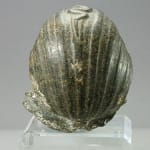New Kingdom Granite Head of a Man, 1580 BCE - 1085 BCE
Granite
height 14.6 cm
height 5 3/4 in
height 5 3/4 in
PF.0160
Further images
This marvelous Egyptian granite head dates from the Golden Age of the New Kingdom. Originally, the bust would have been attached to a larger, complete body; although this has been...
This marvelous Egyptian granite head dates from the Golden Age of the New Kingdom. Originally, the bust would have been attached to a larger, complete body; although this has been lost to us. What does survive, however, is a gorgeous rendering of a smiling, youthful man. He wears a cloth, striped nemes wig, the same type that was immortalized in the famous tomb sculptures of Tutankhamen. The wig is indicative of the pharaohs and was often used in art to indicate social status. A rearing uraeus cobra decorates the front of the headdress. The facial features of the man have been rendered with an idealization typical of Egyptian art. His eyes are wide open and he smiles sweetly, as if greeting the gods in the great beyond. Such a work originally may have been entered alongside the deceased in order to welcome him into the afterlife. It is also possible that it may have decorated a temple of royal palace. The New Kingdom was a veritable Renaissance of Egyptian culture during which some of the most famous monuments of this ancient civilization were created. This magnificent granite bust symbolizes the beauty and refinement of Egyptian art as a whole.
Literature
V1







